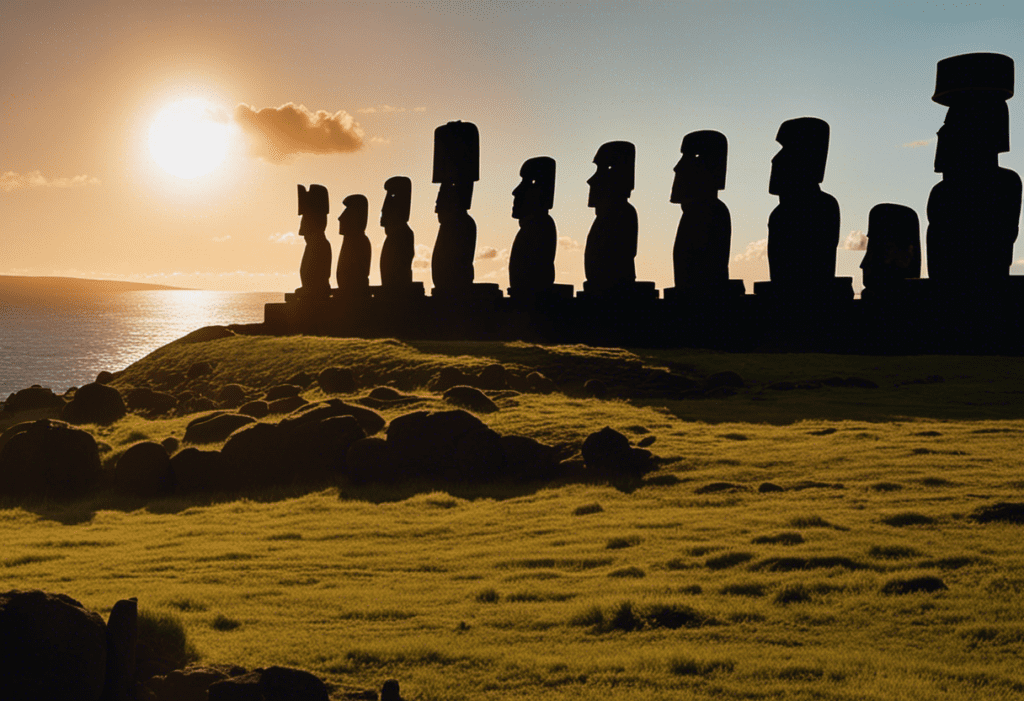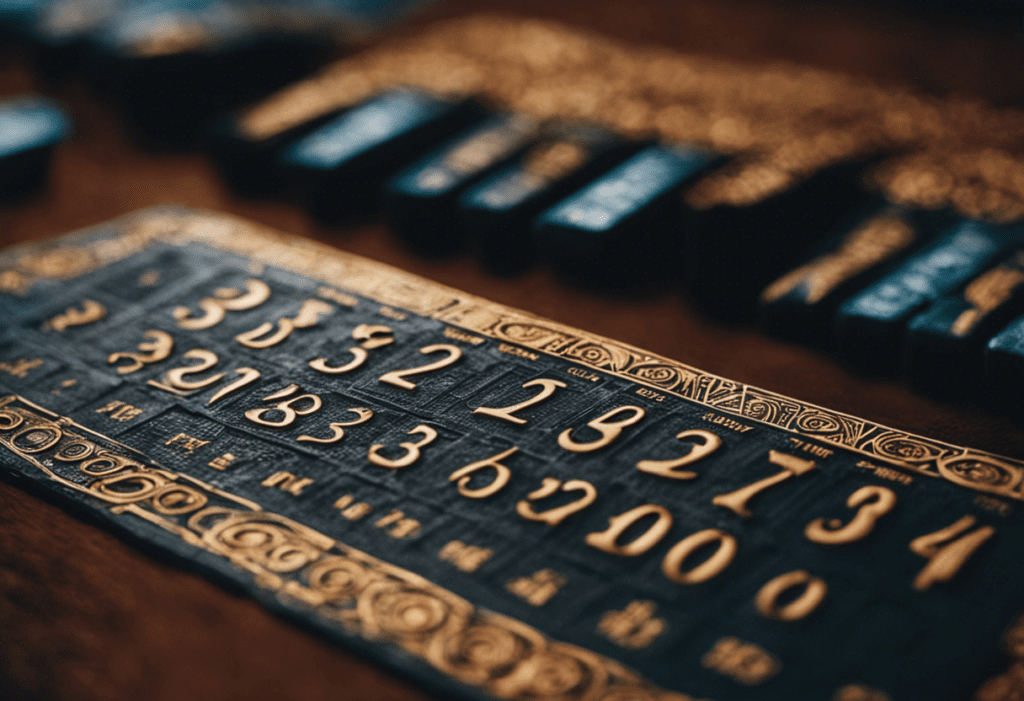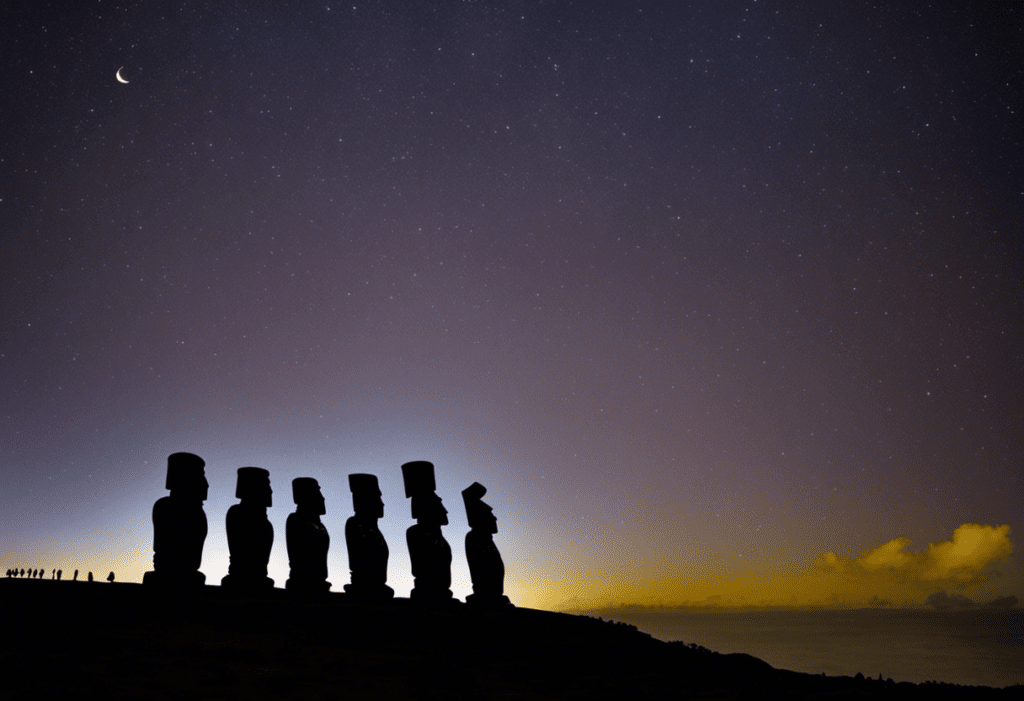Solar alignments play a significant role in the calendar system of Rapa Nui, an intriguing island in the Pacific Ocean.
This article explores the connection between celestial observations and the rich tapestry of Rapa Nui culture.
By analyzing in detail, we uncover how solar alignments help predict agricultural cycles, aid navigation, and shape sacred rituals.
Understanding the legacy of solar alignments provides deeper insights into the seasonal changes and societal customs of this unique society.
Key Takeaways
- Celestial observations, including solar alignments, were integral to the cultural practices and traditions of the Rapa Nui people.
- Solar alignments played a crucial role in predicting agricultural outcomes, influencing fishing patterns, and tracking seasonal changes and climate patterns.
- Solar alignments were used for navigation, helping sailors and explorers determine direction and orientation.
- Solar alignments were significant in the positioning and symbolism of sacred sites, representing a connection between the divine and the earthly.
Celestial Observations and Rapa Nui Culture
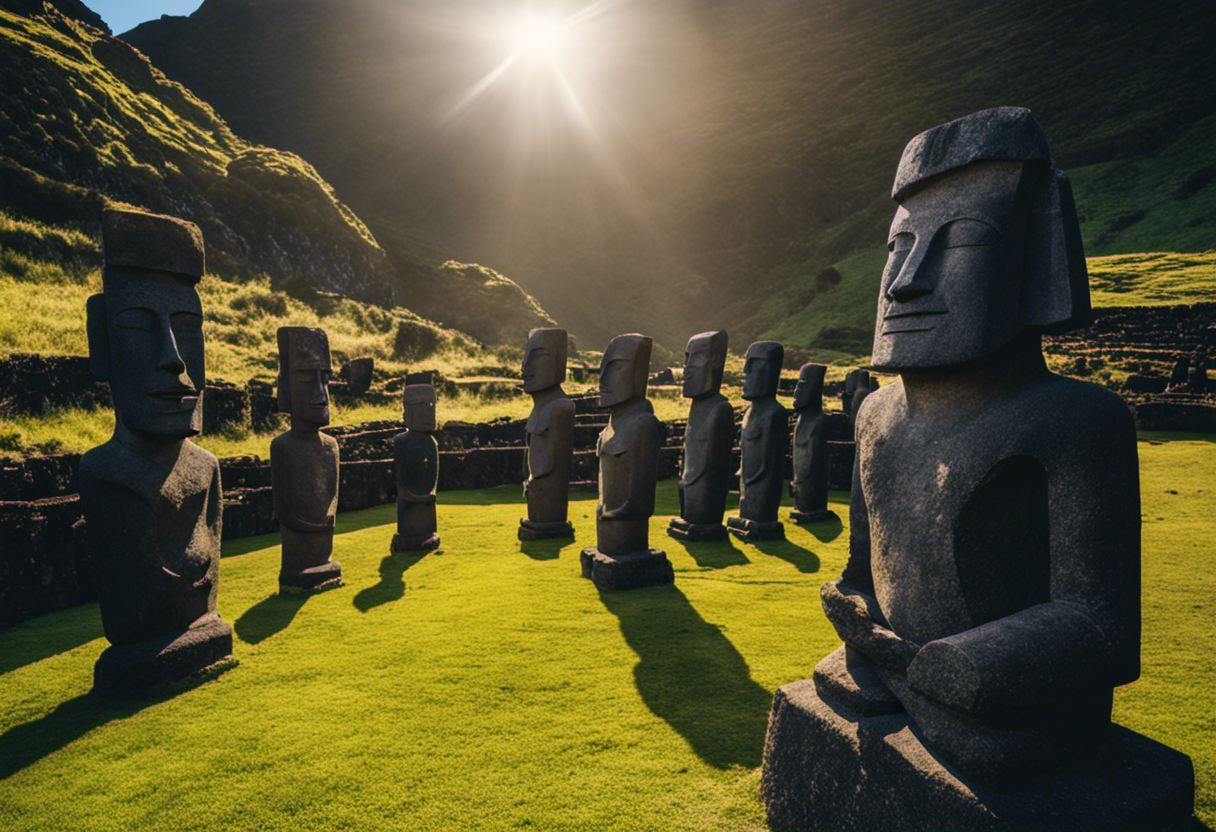

Celestial observations played a significant role in shaping the cultural practices of the Rapa Nui people on Easter Island. Due to the island’s remote location in the Pacific Ocean, the Rapa Nui heavily relied on the natural world for their survival. As a result, they integrated celestial observations into their daily lives. The movements of the sun, moon, and stars were closely monitored, aiding in navigation, determining optimal planting and harvest times, and establishing cultural traditions.
Of particular importance to the Rapa Nui was the alignment of celestial bodies with significant landmarks on the island. One notable example can be found at the ceremonial site of Ahu Akivi, where seven moai statues face the sunset during the spring equinox. This alignment is believed to have served as a marker on their calendar, assisting the Rapa Nui in tracking the changing seasons. These celestial observations were not only tied to practical benefits but also held religious significance. Specific events and rituals were performed during celestial alignments.
These observations not only provided practical advantages but also played a crucial role in shaping the cultural traditions of the Rapa Nui. The knowledge and understanding of celestial bodies were passed down through generations, fostering a deep connection between the Rapa Nui and their environment. The ability to interpret celestial patterns and align them with important landmarks showcased the Rapa Nui’s advanced comprehension of astronomy and their unique relationship with the natural world.
Solar Alignments and Agricultural Predictions
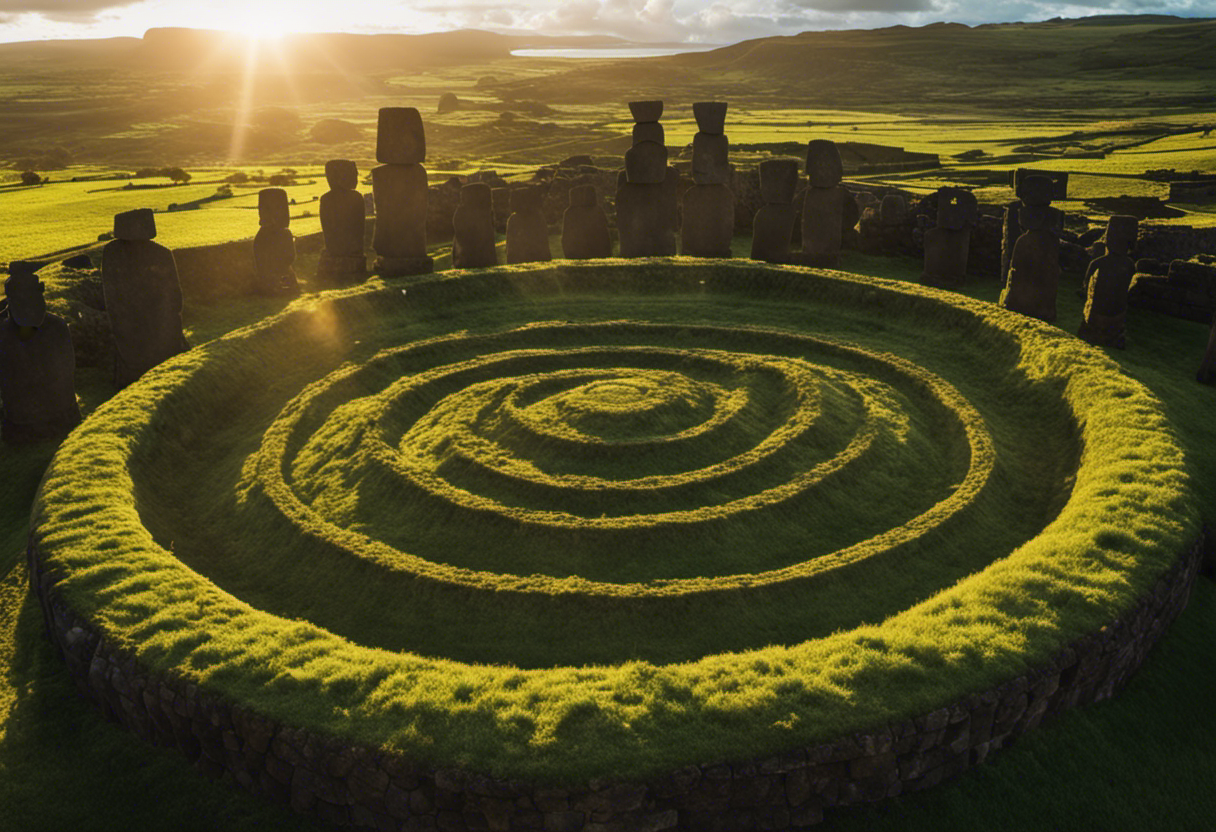

Solar alignments played a significant role in the Rapa Nui calendar, specifically in predicting agricultural outcomes. The ancient inhabitants of Rapa Nui closely observed and recorded the movements of the sun and its alignment with various landmarks on the island. By studying these solar alignments, the Rapa Nui people were able to make accurate predictions about climate patterns and agricultural conditions.
Here are some key ways in which solar alignments influenced agricultural predictions on Rapa Nui:
-
Solar alignments and climate patterns: The Rapa Nui people observed how the sun’s alignment with specific landmarks changed throughout the year. These observations allowed them to predict the arrival of different seasons and anticipate changes in weather patterns. Understanding the sun’s movements helped them determine the ideal time for planting, harvesting, and other agricultural activities.
-
Solar alignments and fishing patterns: In addition to agriculture, the Rapa Nui people relied heavily on fishing as a means of sustenance. Solar alignments provided crucial information about the migration patterns of fish and the availability of certain species in different seasons. By aligning their fishing practices with the sun’s movements, they could maximize their chances of a successful catch.
-
Integration of solar alignments into the calendar: The Rapa Nui calendar was intricately linked to solar alignments. The alignment of the sun with specific landmarks served as markers for important dates and events in the agricultural cycle. This integration allowed the Rapa Nui people to keep track of time and plan their agricultural activities accordingly.
-
Interpretation of solar alignments: The Rapa Nui people developed a deep understanding of the relationship between solar alignments and agricultural outcomes. They had a sophisticated system of interpreting the sun’s movements and predicting the impact on crops and fishing. This knowledge was passed down through generations, ensuring the sustainability of their agricultural practices.
Solar alignments played a crucial role in the Rapa Nui calendar, particularly in predicting agricultural outcomes. By closely observing and interpreting the sun’s movements, the Rapa Nui people were able to make accurate predictions about climate patterns and fishing conditions. This knowledge was vital for their survival and sustainable agricultural practices on the island.
The Role of Solar Alignments in Navigation
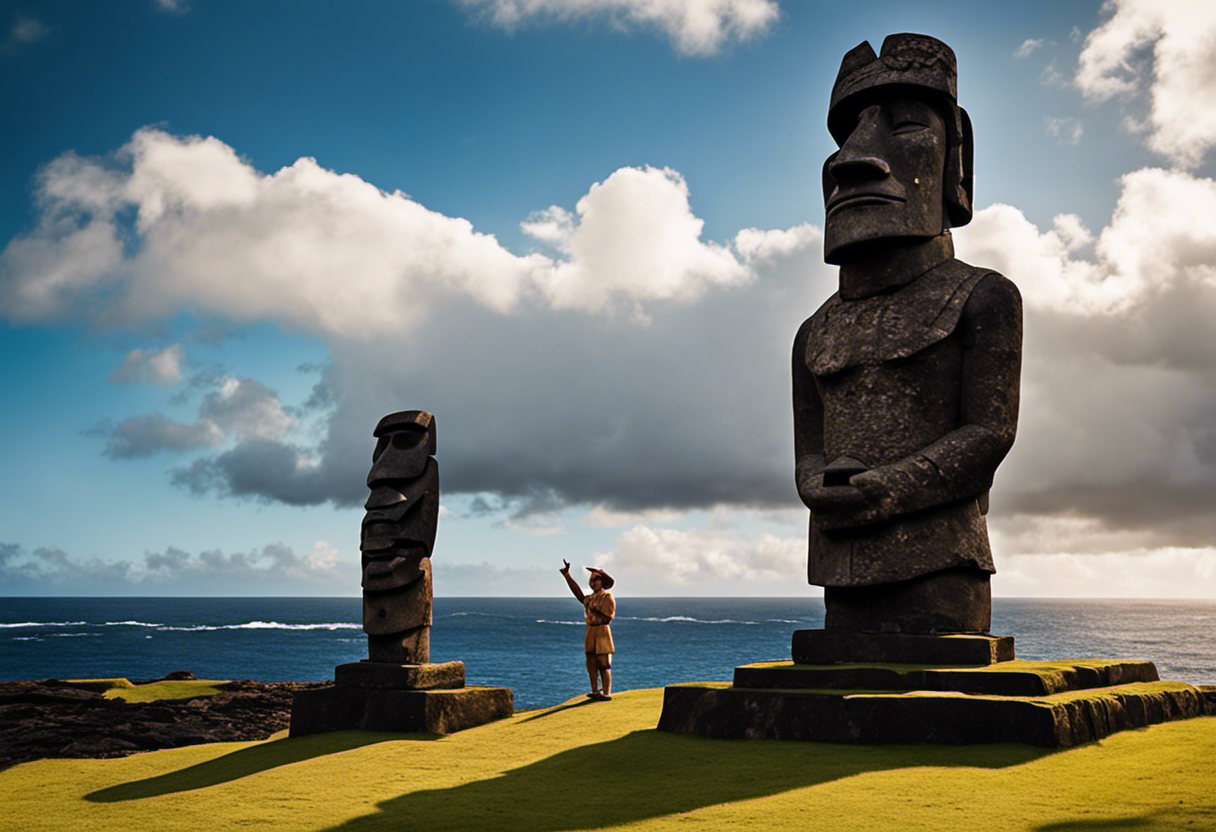

Solar alignments in the Rapa Nui calendar had a broad impact beyond agricultural predictions. They played a crucial role in navigation, which was of utmost importance in ancient civilizations. The influence of these alignments on ancient architecture can be observed in various structures worldwide.
In terms of navigation, ancient civilizations heavily relied on the sun’s position to determine their direction and orientation. Sailors and navigators would observe the solar alignments to ascertain their latitude and longitude. This knowledge allowed them to navigate vast distances and explore new territories. The alignment of the sun with specific landmarks or structures provided a sense of direction and helped them track their position.
The significance of solar alignments in navigation is evident in civilizations like the Mayans. They constructed structures like El Castillo in Chichen Itza with precise alignments to the sun. By observing the shadows cast by these structures at specific times, the Mayans could predict solstices and equinoxes, which were crucial for agricultural and navigational purposes.
Sacred Sites and Solar Alignments
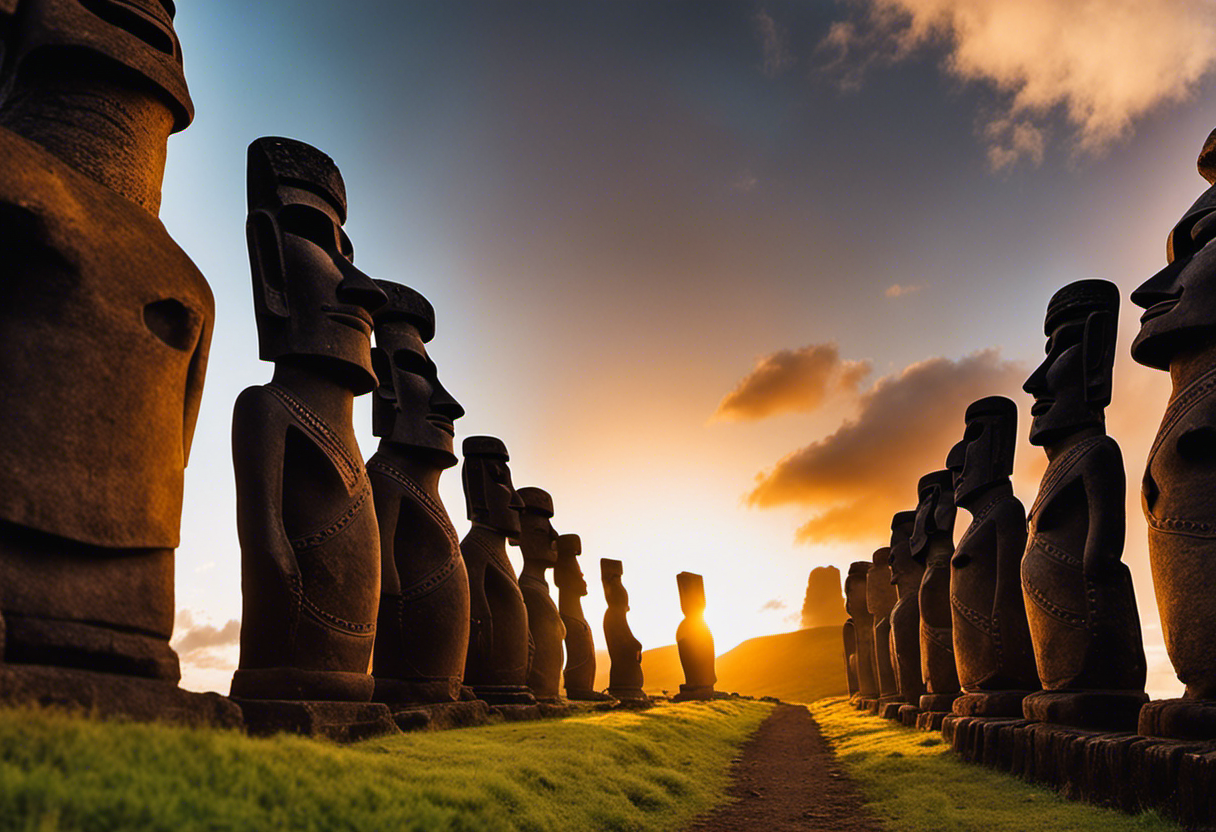

Solar alignments played a significant role in the importance of sacred sites in Rapa Nui. The ancient traditions and rituals of the Rapa Nui people were deeply connected to their understanding and appreciation of celestial phenomena, particularly the sun.
Here are some ways in which solar alignments contributed to the significance of sacred sites:
-
Orientation: Sacred sites were strategically positioned to align with specific solar events, such as solstices and equinoxes. This alignment served as a way to connect the physical and spiritual realms and marked important dates in the Rapa Nui calendar.
-
Symbolism: Solar alignments represented the gods and their power. The alignment of sacred sites with the sun symbolized the connection between the divine and the earthly, reinforcing the religious significance of these locations.
-
Energy: The solar alignments were believed to harness and channel cosmic energy. Sacred rituals and ceremonies performed at these sites during specific solar alignments were thought to tap into this energy, facilitating communication with the gods and enhancing spiritual experiences.
-
Community and Tradition: Solar alignments were integral to the culture and traditions of the Rapa Nui people. They served as a focal point for communal gatherings and celebrations, reinforcing the collective identity of the community and preserving ancient practices.
The solar alignments in the Rapa Nui calendar were not only useful for navigation, but they also held great spiritual importance. They contributed to the significance of sacred sites by providing a tangible connection to the divine, symbolizing the power of the gods, facilitating spiritual experiences, and reinforcing community and tradition. These alignments were a testament to the deep spiritual and cultural heritage of the Rapa Nui people.
Solar Alignments and Rapa Nui Rituals


The solar alignments in Rapa Nui hold great cultural significance as they were closely tied to the ritual practices of the island’s inhabitants. These alignments went beyond mere astronomical observations and served as a foundation for various religious ceremonies and traditions.
The Rapa Nui people had a deep understanding of celestial movements, which allowed them to create rituals intricately connected to the cycles of the sun, moon, and stars. These rituals played a vital role in the spiritual and cultural fabric of Rapa Nui society, showcasing the profound connection between the island’s people and the celestial realm.
Cultural Significance of Alignments
The cultural significance of solar alignments in Rapa Nui is evident in their rituals and practices. The Rapa Nui people have a deep connection with the natural world, including the sun, which holds a central place in their cultural traditions. Solar alignments, such as the solstices and equinoxes, hold important dates in the Rapa Nui calendar. These alignments are not only used to determine the timing of agricultural activities for successful harvests but also play a role in their religious and ceremonial practices.
During specific solar alignments, Rapa Nui rituals and ceremonies take place to honor their ancestors and seek their blessings. Additionally, solar alignments influence the construction and orientation of significant structures like the Moai statues, showcasing the cultural importance of these celestial events.
Solar alignments are a testament to the Rapa Nui people’s deep understanding of the natural world and their ability to incorporate it into their daily lives. These alignments serve as a reminder of the interconnectedness between nature and culture, and highlight the unique cultural heritage of the Rapa Nui people.
Ritual Practices and Alignments
Ritual Practices and Alignments
Rapa Nui rituals and ceremonies are closely tied to solar alignments, showcasing the deep cultural reverence the people of Rapa Nui (also known as Easter Island) have for celestial events. These ceremonies held immense significance in their lives and the well-being of their community.
Solar symbolism played a vital role in these rituals, as the alignment of the sun with specific structures or natural landmarks was believed to bring blessings and prosperity. For instance, the strategically placed moai statues on the island were designed to align with the rising and setting sun during specific times of the year, marking important dates in the Rapa Nui calendar.
These alignments were not mere symbols, but integral components of the ritual practices that defined the spiritual and cultural identity of the Rapa Nui people.
Astronomical Knowledge and Rituals
Deep knowledge of celestial phenomena and their alignment with significant structures and landmarks played a vital role in the astronomical understanding and rituals of the Rapa Nui people on Easter Island.
Their astronomical traditions were intricately connected to their cultural practices and beliefs, shaping their celestial ceremonies and rituals.
The Rapa Nui people carefully observed and studied the movements of the sun, stars, and planets, using this knowledge to accurately predict celestial events like solstices and equinoxes.
They then incorporated this astronomical knowledge into their rituals and ceremonies, which often took place at specific locations on the island that aligned with celestial bodies.
These rituals held great importance in marking significant events in the Rapa Nui calendar, such as planting and harvesting seasons, and were believed to establish a connection between the earthly and celestial realms.
Solar Alignments and Seasonal Changes
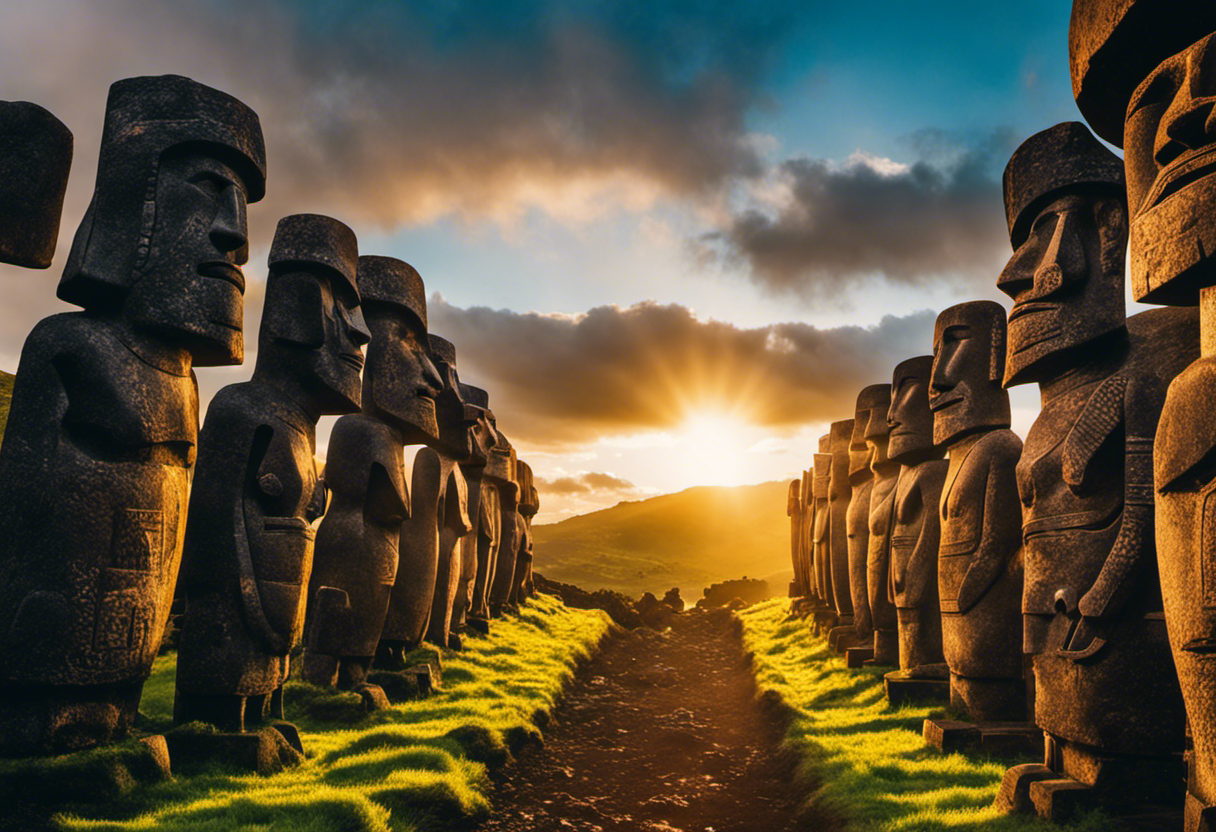

The alignment of celestial bodies and the changes in seasons are intricately connected in the Rapa Nui calendar. Solar alignments play a crucial role in tracking the seasonal changes and climate patterns on the island. Ancient civilizations, including the Rapa Nui people, recognized the significance of these alignments in predicting the shifts in weather and agricultural cycles.
Solar alignments and climate change are closely intertwined as changes in the Earth’s axial tilt and orbital position result in variations in solar radiation reaching different parts of the globe. The Rapa Nui people, through careful observation and knowledge of celestial movements, were able to anticipate these variations and adapt their agricultural practices accordingly. By aligning their structures and monuments with the Sun’s position during specific times of the year, they could mark the changing seasons and determine the most favorable times for planting, harvesting, and other agricultural activities.
The Rapa Nui calendar, with its solar alignments, allowed the ancient civilization to effectively manage their limited resources and maintain their sustenance in a challenging environment. It also highlights the deep connection between the Rapa Nui people and their natural surroundings, as they relied on celestial cues to navigate their daily lives. This intricate understanding of solar alignments demonstrates the advanced knowledge and intelligence of these ancient civilizations and their ability to adapt to the ever-changing environment.
The Legacy of Solar Alignments in Rapa Nui Society
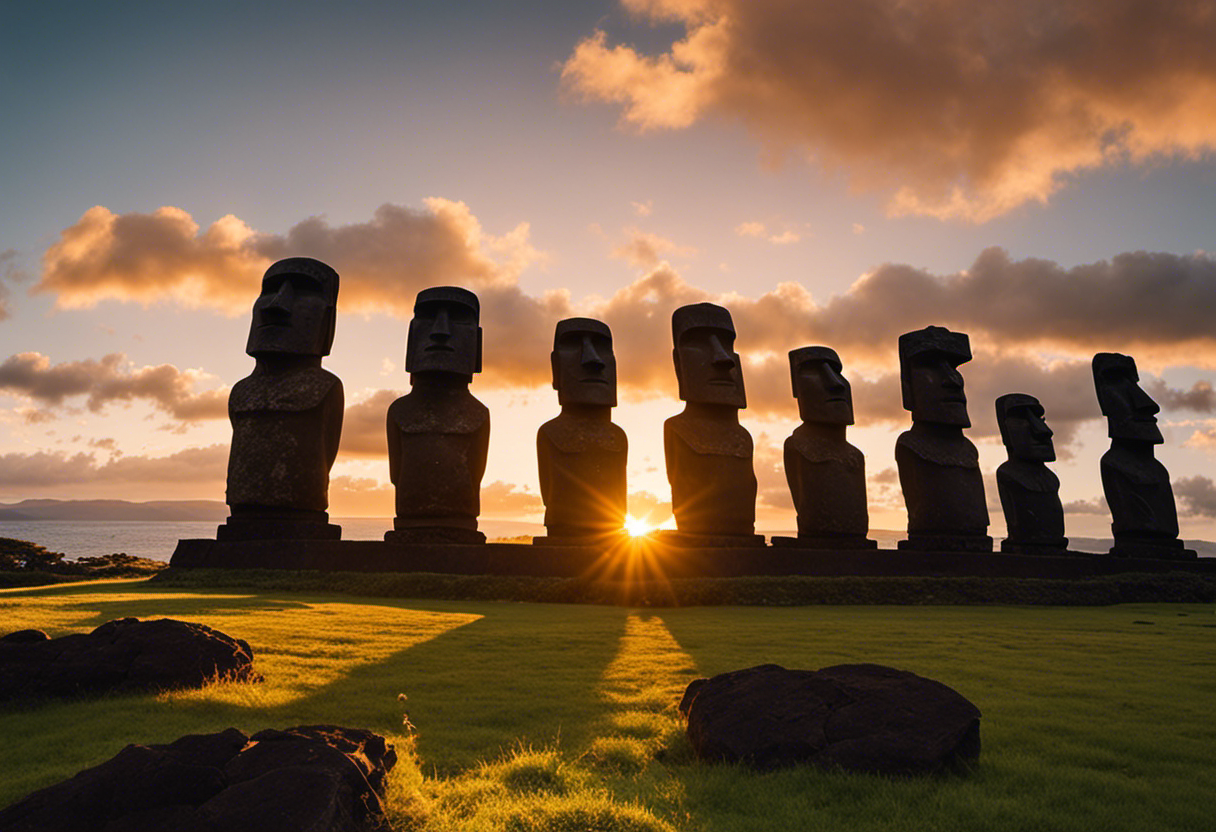

The Impact of Solar Alignments on Rapa Nui Society
Solar alignments have had a lasting influence on the cultural and societal fabric of Rapa Nui. These alignments can be observed in various aspects of the island’s society, including their economic significance and cultural preservation.
Economic Impact of Solar Alignments:
The alignment of solar events with important landmarks on the island has attracted tourists from all over the world. This influx of visitors has greatly contributed to the local economy by creating job opportunities and boosting tourism-related businesses.
Additionally, the presence of solar alignments has prompted the development of infrastructure and services to accommodate the growing number of tourists. This has further stimulated the economy, creating a ripple effect on other sectors.
Cultural Preservation through Solar Alignments:
The knowledge and understanding of solar alignments have been passed down through generations, ensuring the preservation of Rapa Nui’s rich cultural heritage. This knowledge is deeply ingrained in the societal practices and customs of the island’s inhabitants.
Traditional ceremonies and festivals continue to celebrate and observe solar alignments, playing a crucial role in maintaining and reinforcing cultural identity and pride.
In conclusion, the legacy of solar alignments in Rapa Nui society is twofold, encompassing both economic benefits and cultural preservation. The alignment of the sun with significant landmarks has not only brought prosperity to the island but has also played a vital role in keeping cultural traditions alive.
Quote: ‘Solar alignments have become an integral part of Rapa Nui’s identity, attracting tourists and preserving our cultural heritage.’ – Local resident.

